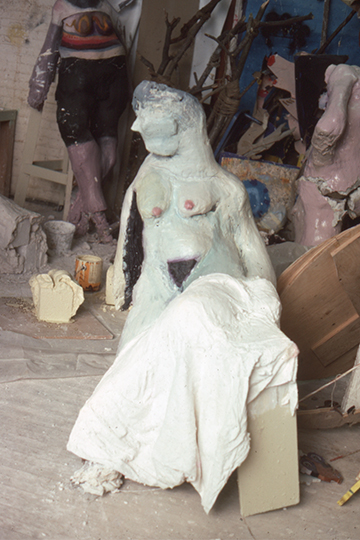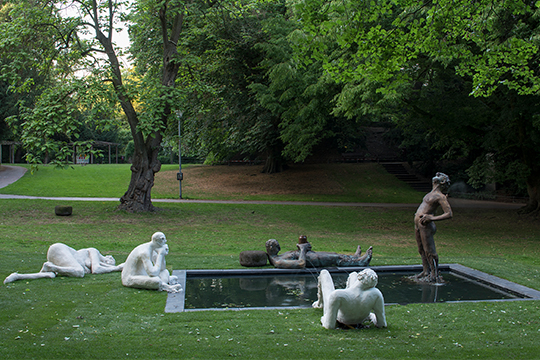I found a couple of images recently through my best friend in college, Molly Bradford. Molly had pictures of a project we did together; in fact, Molly really began this project, and I joined her in it. This is from my freshman year at Rhode Island School of Design, and it was Christmas break. We had a month off for winter break, and the first week everybody left, Molly and I stayed in school, and everybody was gone. There was empty space, a lot of the project rooms had been cleared out. So, Molly and I found a project room and started dragging junk into it like an old bed springs and broken furniture and this and that and building these armatures. Then we went to the store and bought hundreds of pounds of plaster, and we actually stole a lot of plaster—that's how we were back then; we were little thieves. We would buy one bag of plaster and roll out of the store with three of them on the trolley. But we were students on a limited budget, so that's how we did it, and we built these sculptures. We built about seven or eight of them that week and then left. We both went home for the holidays.
 A couple of weeks later, they were discovered by somebody at school, and we almost got suspended, and our parents ended up cleaning up our mess for us. They had to pay the school to have them demolished and thrown away, and we had made a big mess making them.
A couple of weeks later, they were discovered by somebody at school, and we almost got suspended, and our parents ended up cleaning up our mess for us. They had to pay the school to have them demolished and thrown away, and we had made a big mess making them.
But it was amazing for me to discover that she had these images from 30-something years ago. I haven't forgotten about it, but I forgot what they looked like, and I forgot how good they really felt. It was a project born out of friendship, a really important aspect—learning at that point in life, at the age of 18, that art didn't just happen on a piece of paper in my bedroom or in an art class in school. That it was a social activity. That you could think bigger and make bigger.
So, I went through RISD as a painter. I graduated, came to New York, and dabbled in sculpture in the 90s. I never fully committed. But then, in 2011, I was offered to do a project in London at Studio Voltaire, and they said, “Come do something outside of your regular practice.” I remembered this sculpture thing from college, and I asked them to get me 1,000 pounds of plaster and $700 worth of two-by-fours. I spent three weeks there, making maybe one sculpture every two days or so. I ended up with about 15 or 16 sculptures, in an old church in the South of London. On the airplane over, I had made some thumbnail sketches of different gestures I was interested in building up. When I got there, we had a couple of assistants, and we were pulling tarot cards, and would decide on the gesture of the sculpture that day based on the card we pulled. There are similarities to some of those sculptures from RISD from 1985. And back at RISD, we were doing some of those same things, like pulling old desks and mattresses off the street and integrating them into the installation and working that way. It was a space that really had this feeling of being a workshop.
Then came Münster. So, Kasper König had seen this work at Studio Voltaire. I was really interested in the idea of presenting a workshop on sculpture, building these things in situ. He asked me in 2012, I think, for a proposal for the Münster Sculpture Projects, a show that he has curated for over 50 years. He started doing it when he was in his 20s, and he does it every 10 years. The last one he did, in 2017, when he was 75, was the one where I presented this piece, Sketch for a Fountain, that is now in the Nasher garden, or a version of it. This process was interesting to me in thinking about public art for the first time, and context. I was thinking about how the pieces used who's in relationship to them, depending on the neighborhood. I mean, the demographic of Münster is pretty like, you know, wealthy-liberal-white-bourgeoisie kind of looking place, but within that, there are students. There is a Turkish community, and there are a lot of senior citizens, and so there are other micro-communities. So, I thought about context and how you want to approach the work. Is it something you want to get on a bicycle and ride half a mile to see and discover in the woods somewhere? Or is it going to be more in an urban place in the city and you drive by it and you can see it that way?
 So, looking at the history of the Münster Sculpture Projects I remembered seeing a Martin Kippenberger sculpture when I was a student from one of the earlier iterations of the show. I really was down with this Kippenberger. He built an underground ventilation shaft used for subways and put them on this lawn. I remember photographs from Artforum, and then when I got to Münster, I recognized the lawn. I was like, that's it. I have to do my piece where he did his piece. The lawn was really elegant to me. It was like the equivalent of a white cube gallery, as close as you could get to a perfect arcadian space outdoors in Münster. It had a backdrop of a hill which, at some point in Münster in the 70s and 80s, was a gay cruising area, so that was a nice kind of connection.
So, looking at the history of the Münster Sculpture Projects I remembered seeing a Martin Kippenberger sculpture when I was a student from one of the earlier iterations of the show. I really was down with this Kippenberger. He built an underground ventilation shaft used for subways and put them on this lawn. I remember photographs from Artforum, and then when I got to Münster, I recognized the lawn. I was like, that's it. I have to do my piece where he did his piece. The lawn was really elegant to me. It was like the equivalent of a white cube gallery, as close as you could get to a perfect arcadian space outdoors in Münster. It had a backdrop of a hill which, at some point in Münster in the 70s and 80s, was a gay cruising area, so that was a nice kind of connection.
Kasper König asked for a proposal, and getting him something was a big rush. He says, “Just give me something, doesn't matter. We can always change it, but just have some idea.” So, the first thing that popped into my head was the idea of organizing figures around a body of water. You know, at the fountain, the water becomes a kind of an excuse, a gathering place for the figures, and anything could happen around it; it doesn't really matter what the figures are doing. I built the figures in a foundry in Düsseldorf. They're made out of plaster with foam inside them.
So, the show opened and this lawn is in a residential neighborhood, and there's a school nearby. Many kids would come after school and hang out; people would come to hang out in this park, make little barbecues, and bring little hibachi. It was a social space for this neighborhood, and I was concerned about interrupting that social space by putting the sculptures there, but then maybe it balanced out because kids could also get in the fountain and splash around. Indeed, they did, which made me really happy, and then the show opened, and there were a lot of visitors. I hadn’t taken into account the traffic volume for this show in Münster. They had like a million visitors throughout the show, so it was heavily trafficked, and the lawn got decimated quickly. The dirt from the ground would go into the water, then into the pipes of the sculpture, and clog it up, so we were constantly draining the pool, cleaning out the plumbing, and reconfiguring it.
We wanted to see what it would be like to have these plaster figures outdoors for four months and how people lived with them. You know, the plaster fell apart, and it was like watching a body decay. The sculptures are made from porous materials, and porous materials age like humans do.
This text was excerpted and adapted from a lecture delivered on September 21, 2019, at the Nasher Sculpture Center as part of the 360 Speaker Series.
IMAGES, TOP: Nicole Eisenman, ‘Tis but a scratch’ ‘A scratch?! Your arm’s off!’ ‘No, it isn’t’. Plaster, wood, mixed media, dimensions vary. Installation view, Studio Voltaire, London, 2012. Photo: Andy Keate, courtesy the artist.
MIDDLE: Molly Bradford and Nicole Eisenman, Untitled. Plaster and mixed media, dimensions vary. Installation view, 1984. Image courtesy Molly Bradford and Nicole Eisenman.
BOTTOM: Nicole Eisenman, Sketch for a Fountain, 2017. Bronze, Plaster, basin, dimensions vary. Installation view of Skulptur Projekte 2018.